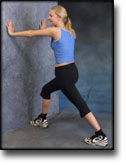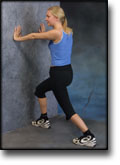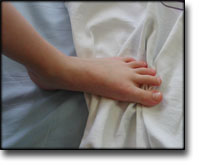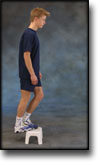|
Treatment of proximal plantar fasciitis with ultrasound-guided steroid injection.
Tsai WC, Wang CL, Tang FT, Hsu TC, Hsu KH, Wong MK. Arch Phys Med Rehabil 2000 Oct;81(10):1416-21.
OBJECTIVE.
To investigate the efficacy of ultrasound-guided steroid injection for the treatment of proximal plantar fasciitis and to evaluate mechanical properties of the heel pad after steroid injection.
DESIGN.
Proximal plantar fascia and heel pad were assessed with a 10-MHz linear array ultrasound transducer. Pain intensity was quantified with a tenderness threshold (TT) and visual analog scale (VAS). The transducer was incorporated into a specially designed device to measure mechanical properties of the heel pad. Evaluations were performed before injection and at 2 weeks and 3 months after injection.
SETTING.
An outpatient clinic of a tertiary care center.
PATIENTS.
Fourteen consecutive patients with unilateral proximal plantar fasciitis.
INTERVENTION.
Ultrasound-guided injection of 7 mg betamethasone and 0.5 mL of 1% lidocaine into the inflamed proximal plantar fascia.
MAIN OUTCOME MEASURES.
VAS, TT, heel pad and plantar fascia thickness, and echogenicity of the proximal plantar fascia on sonogram were assessed. Mechanical properties included unloaded heel pad thickness, compressibility index, and energy dissipation ratio.
RESULTS.
Both VAS score +/- standard deviation (SD; 5.43 +/- 2.03, 1.39 +/- 2.19, 0.57 +/- 1.40 at the 3 measurements, respectively) and TT +/- SD (5.05 +/- 1.42, 9.34 +/- 1.84, 9.93 +/- 1.98 kg/cm2 at the 3 measurements, respectively) improved significantly (p < .001) after steroid injection. The mean thickness of the plantar fascia was greater in the symptomatic side than in the asymptomatic side before treatment (0.58 +/- 0.13 cm vs 0.40 +/- 0.11 cm, p < .001). The thickness had decreased significantly 3 months after injection (0.46 +/- 0.12 cm at 2 weeks, 0.42 +/- 0.10 cm at 3 months, p < .001). The hypoechogenicity at the proximal plantar fascia disappeared after steroid injection (p < .001). Mechanical properties of the heel pad did not change 3 months after steroid injection (p > .05).
CONCLUSION.
Ultrasound offers an objective measurement of the therapeutic effect on proximal plantar fasciitis. Accurate steroid injection under ultrasound guidance can effectively treat proximal plantar fasciitis without significant deterioration of the mechanical properties of the heel pads.
|













